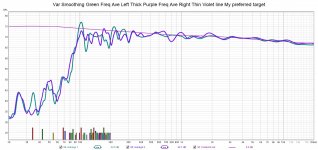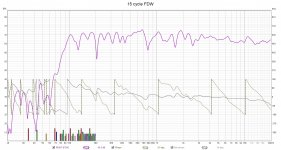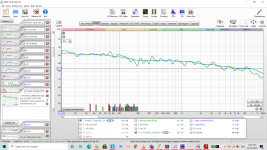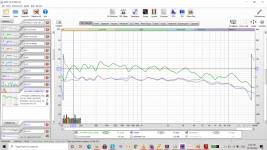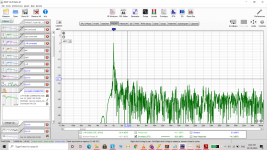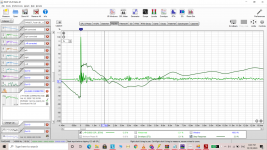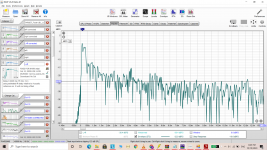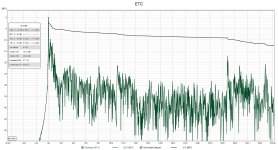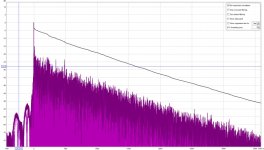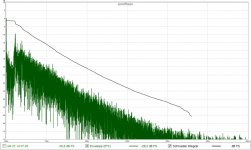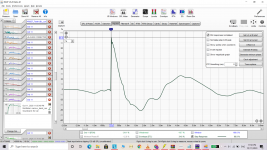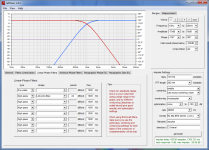Yes 🙂does this work?
I've had a look, it didn't take long. The measurements are very consistent across the average which is a good start. Have you got a subwoofer crossover in place as there is almost nothing below 100Hz?
Above 300Hz I don't see the need to do anything. Below that the room takes over but it's not really that bad. Without more low end to work with it would be difficult to do much.
As you can see in this graph with a basic frequency average applied and var smoothing the speaker already tracks my preferred target to within a dB or two down to 300Hz. I would say this speaker sounds good already but the response there is in desperate need of a subwoofer.
Attachments
Yes 🙂
I've had a look, it didn't take long. The measurements are very consistent across the average which is a good start. Have you got a subwoofer crossover in place as there is almost nothing below 100Hz?
Above 300Hz I don't see the need to do anything. Below that the room takes over but it's not really that bad. Without more low end to work with it would be difficult to do much.
As you can see in this graph with a basic frequency average applied and var smoothing the speaker already tracks my preferred target to within a dB or two down to 300Hz. I would say this speaker sounds good already but the response there is in desperate need of a subwoofer.
IIR filters are already applied here to have this response..
Without it it's brighter with more picks and dips, it's a mess. The left speaker measures every different fom the right, even the levels do not match.
I'm crossing them at 100 hz yes, using a few front loaded horn subs i built resulting in a flat response down to 12 hz.
Would you prefer measurements without PEQ? With added subs?
What about the phase response?
The impulse? Waterfall? ETC?
Have you noticed the rt60 is linear at 0.2 seconds above 200 hz? What's your opinion on that?
Did you notice the interference between the speakers causing cancelation and big dips?
Last edited:
I'll put a little bit of information in here for you but me analysing your measurements to that depth doesn't have much to do with the topic at hand. I know you have been using rephase but we are drifting here. If you want to continue in more depth then a separate thread might be more appropriate.
I wanted to see the original measurements rather than with any EQ applied to get a better idea of the raw response. Anything can be beaten into shape with enough EQ applied so seeing the raw measurements is useful.
There is an issue with your Left tweeter it almost looks like it is wired out of phase as there is a deep dip at 6.5K which is not there in the right channel. Would be worth checking to see if it is wired the same or damaged in some way.
The phase looks just the way you would expect a passive crossover to look it is quite smooth in general. The crossover points I have seen listed on the internet don't seem to match the measurements but in room responses are not ideal for that kind of detective work.
I would say you have a lot of absorbent material but not much that is working below 200Hz which is why the decay takes off there. Your room is very much on the dead side at 200ms or under, I would say that you might be better taking some of it out or looking to actively add ambience back in.
If you really want a nicer looking impulse response I think tools like DRC_FIR are a better way to get there, no offence to rephase intended.
I wanted to see the original measurements rather than with any EQ applied to get a better idea of the raw response. Anything can be beaten into shape with enough EQ applied so seeing the raw measurements is useful.
There is an issue with your Left tweeter it almost looks like it is wired out of phase as there is a deep dip at 6.5K which is not there in the right channel. Would be worth checking to see if it is wired the same or damaged in some way.
The phase looks just the way you would expect a passive crossover to look it is quite smooth in general. The crossover points I have seen listed on the internet don't seem to match the measurements but in room responses are not ideal for that kind of detective work.
I would say you have a lot of absorbent material but not much that is working below 200Hz which is why the decay takes off there. Your room is very much on the dead side at 200ms or under, I would say that you might be better taking some of it out or looking to actively add ambience back in.
If you really want a nicer looking impulse response I think tools like DRC_FIR are a better way to get there, no offence to rephase intended.
I'll put a little bit of information in here for you but me analysing your measurements to that depth doesn't have much to do with the topic at hand. I know you have been using rephase but we are drifting here. If you want to continue in more depth then a separate thread might be more appropriate.
I wanted to see the original measurements rather than with any EQ applied to get a better idea of the raw response. Anything can be beaten into shape with enough EQ applied so seeing the raw measurements is useful.
There is an issue with your Left tweeter it almost looks like it is wired out of phase as there is a deep dip at 6.5K which is not there in the right channel. Would be worth checking to see if it is wired the same or damaged in some way.
The phase looks just the way you would expect a passive crossover to look it is quite smooth in general. The crossover points I have seen listed on the internet don't seem to match the measurements but in room responses are not ideal for that kind of detective work.
I would say you have a lot of absorbent material but not much that is working below 200Hz which is why the decay takes off there. Your room is very much on the dead side at 200ms or under, I would say that you might be better taking some of it out or looking to actively add ambience back in.
If you really want a nicer looking impulse response I think tools like DRC_FIR are a better way to get there, no offence to rephase intended.
i appreciate your help again and sorry drifting off the topic, if you can send me a link of another appropriate thread i'll continue this topic there.
apparently i do have a problem with my left tweeter, the left channel raw response is showing a 6 db valley dip at 6.5 khz, i;ll troubleshoot the tweeter and see what happens.
do you have any theory as to why i'm seeing bad inteferance between the left and right speaker? i used rephase thinking it's a phase issue..this did also happen when the tweeter was working fine.
I've read about rt60 not being very useful and accurate in measuring small rooms as mine, the absorbers i'm using are 5 cms rockwool and the first reflections only, taking them out of the room didn't do anything to my rt60..
i wonder how you were able to determine how smooth the phase is😕
i only see a line going to 3000 degrees when i look at the spl phase part in REW..
Just start a new thread and put a link back here, you will probably get more input that way too 🙂
I don't see much in the way of issues between both speakers except at the highest frequencies. I suspect that has something to do with the damaged/mis wired tweeter, the dipole nature of the drivers and the fact that your room is very absorbent.
RT60 is not very helpful in small rooms as a general measure but it can be useful to get an idea of how live or dead the room is and how even the decay is.
To view the phase use a Frequency dependent window, 15 cycles or less, wrap the phase, generate the minimum phase and see where there is agreement. Like in the screenshot below. The wraps go up and down but the features of the minimum phase version are still intact. Below 100Hz it gets messy fast.
I don't see much in the way of issues between both speakers except at the highest frequencies. I suspect that has something to do with the damaged/mis wired tweeter, the dipole nature of the drivers and the fact that your room is very absorbent.
RT60 is not very helpful in small rooms as a general measure but it can be useful to get an idea of how live or dead the room is and how even the decay is.
To view the phase use a Frequency dependent window, 15 cycles or less, wrap the phase, generate the minimum phase and see where there is agreement. Like in the screenshot below. The wraps go up and down but the features of the minimum phase version are still intact. Below 100Hz it gets messy fast.
Attachments
Yes it can on the "Linear-Phase Filters" tab as seen in first visual below, but dont do the same on the system stopbands in its not how sound is in nature so system stopbands need same phaseshift as their minimum phase roll off slope will dictate as in the second example. What you like to do looking your example is linearize the allpass phase behavour (phase distortion) of summing two normal bandpasses, in practical there is two ways to do that in Rephase, one method is import your bandpass measurement to Rephase then EQ its slope flat as a pancake using whatever minimum phase EQ filters and finally add your target slope on that "Linear-Phase Filters" tab, second method is import your bandpass measurement to Rephase then EQ its slope smooth to hit the target curve slope using whatever minimum phase EQ filters and finally linearize the slopes phase distortion on the "Filters Linearization" tab picking same slope as was your target curve, hope it helps and have fun.
I got some questions, after reading a guide.
How do you get your red band in, in rePhase? with the same tabs i only get the high pass in.
Do you recommend older rephase to fit the guide on minidsp site?
a lot of mystical extra names now under 'impulse settings' 😱
Old guide: https://www.minidsp.com/images/appnotes/rephase/rephase-settings.png
If i interprate your post right the joint is the focus for rephasing not the whole spectra? (I will use active 3 or 4-way speakers)
And is stop band the same as passband?
Thank's!
Last edited:
Passband means the frequency range of interest in this case it would be 20Hz to 20KHz or whatever range you are interested in. The Stop bands are the parts outside that where the response of the system is falling at either end.
To change to low pass just press the down arrow next to high pass and it will bring a box up where you can choose.
The settings in that guide can be copied. I would assume that the MiniDSP guys found those settings to produce the best fit for the number of taps their device has. You can experiment with them fairly easily. Rephase will show you on the screen how close it was able to come to the target. If you don't like it try different settings but with 6144 taps there is only so much that can be done to low frequencies.
No need to use an old version of rephase copy those settings or choose your own.
To change to low pass just press the down arrow next to high pass and it will bring a box up where you can choose.
The settings in that guide can be copied. I would assume that the MiniDSP guys found those settings to produce the best fit for the number of taps their device has. You can experiment with them fairly easily. Rephase will show you on the screen how close it was able to come to the target. If you don't like it try different settings but with 6144 taps there is only so much that can be done to low frequencies.
No need to use an old version of rephase copy those settings or choose your own.
Just start a new thread and put a link back here, you will probably get more input that way too 🙂
I don't see much in the way of issues between both speakers except at the highest frequencies. I suspect that has something to do with the damaged/mis wired tweeter, the dipole nature of the drivers and the fact that your room is very absorbent.
RT60 is not very helpful in small rooms as a general measure but it can be useful to get an idea of how live or dead the room is and how even the decay is.
To view the phase use a Frequency dependent window, 15 cycles or less, wrap the phase, generate the minimum phase and see where there is agreement. Like in the screenshot below. The wraps go up and down but the features of the minimum phase version are still intact. Below 100Hz it gets messy fast.
I finally figured everything out! the difference the my eyes is amazing.
i was generating 48khz in REphase instead of 96.. that was the whole problem basically, and a bit of delay problems aswell.
i'm attaching corrected vs uncorrected pictures ,the difference is so obvious i don't need to specify the corrected vs uncorrected ones. please give me your opinion!
Attachments
Just start a new thread and put a link back here, you will probably get more input that way too 🙂
I don't see much in the way of issues between both speakers except at the highest frequencies. I suspect that has something to do with the damaged/mis wired tweeter, the dipole nature of the drivers and the fact that your room is very absorbent.
RT60 is not very helpful in small rooms as a general measure but it can be useful to get an idea of how live or dead the room is and how even the decay is.
To view the phase use a Frequency dependent window, 15 cycles or less, wrap the phase, generate the minimum phase and see where there is agreement. Like in the screenshot below. The wraps go up and down but the features of the minimum phase version are still intact. Below 100Hz it gets messy fast.
About the my room being dead, i've followed the RFZ(reflection free zone) protocol in my room, treating all the first reflection point that needs treating and making sure the initial time delay gap is big, the ETC graph i've attached in my previous post shows that the first reflections are tamed below 20 db(from 1 khz to 8 khz) for more than 15 ms, which is excellent according to the European Broadcasting Union and Telecommunications Union's recommendations, so basically this is what it takes to hear the recording as intended,E.G. the spatial characteristic of a hall with stunning realism… a true sense of width and depth.
at least this is how i understand it.. is there something i'm missing? requiring a specific RT60 for a HI FI listening room?
Glad you got it worked out. I had a few troubles myself making filters for others MiniDSP units fixed at 96K. It's hard to give an opinion because anything can be forced to any shape with enough processing. You have done a good job of flattening the phase and correcting the impulse response but the consequences of that are visible in the way the step response goes down before it comes up and the fuzziness of the start of the impulse response. That is the trade off for time correction.I finally figured everything out! the difference the my eyes is amazing.
i was generating 48khz in REphase instead of 96.. that was the whole problem basically, and a bit of delay problems aswell.
please give me your opinion!
Make another filter with only PEQ and no phase correction and compare the two by switching back and forth. Preferably without knowing which is which. Decide if you can actually tell the difference and then if you have a preference. It is very easy to please your eyes with graphs but they don't always please your ears. If it looks good but sounds bad you have to work out why.
The windowing you use to base your corrections on will have a big influence on the tonal balance. The shape of the curve will change over time due to the influence of reflections. I usually start with a 15 cycle FDW and 1/6 smoothing and use auto and manual EQ in REW to get close to my target. I find this to be representative of what I hear and is a good base for the processing I do after.
Most recommendations for decay time put it in the range of 300 to 400ms for a comfortable environment. 250ms is low and 200ms is getting to be studio control room dead. Controlling the first reflections is fine but you have to be careful that you don't also kill all the later reflections too. Spaciousness, apparent source width, envelopment are all terms used in room and concert hall acoustics. The level and timing of reflections for listening is a very big subject. Standards are fine, just like tutorials but without an understanding of the background to the recommendations you can miss the wood for the trees.About the my room being dead, i've followed the RFZ(reflection free zone) protocol in my room, treating all the first reflection point that needs treating and making sure the initial time delay gap is big, the ETC graph i've attached in my previous post shows that the first reflections are tamed below 20 db(from 1 khz to 8 khz) for more than 15 ms, which is excellent according to the European Broadcasting Union and Telecommunications Union's recommendations, so basically this is what it takes to hear the recording as intended,E.G. the spatial characteristic of a hall with stunning realism… a true sense of width and depth.
at least this is how i understand it.. is there something i'm missing? requiring a specific RT60 for a HI FI listening room?
Here is an ETC from my system. You will see that the reflections are controlled in the same way as yours but my decay time is in the 300 to 350ms range and there is a Haas kicker of sorts at 28ms. This is natural because of the room being open from the front to the back via another room. If it wasn't there naturally I would have put it in and I still plan to shape it with a pair of ambience speakers.
Reflections don't have to be absorbed, they can be redirected with reflection panels to arrive later in time, this might be something to look at as you say your room is just as dead without the first reflection panels. We are a long way from rephase here though. If you want to discuss this more just make a new thread, you will get lots of different opinions and input 😉
Attachments
Hi zallou3,
If your setup is meant for pure listening entertainment, robbing the room of all it's energy might not be the best thing. By absorbing the first 15 to 20 ms, the room will become a much more dead environment. It is clear from your IR pulse there isn't much late arriving energy. While this may be great for imaging, in my humble opinion it isn't the best thing for pure listening enjoyment. I once was on a road similar to yours. Absorbing all first reflections to enhance my listening experience. However, I did spend quite some time in my room before hanging up all those panels and remembered fondly how that experience knocked me off my feet quite a few times. With big orchestra's and the room not quite yet as damped, it gave me a thrill of being there, in the room where the orchestra was playing. With all the panels in place, I could pinpoint instruments, have a great stage but there was something missing. Things like the feel of envelopment, like fluid mentioned... the thrill of being part of the performance/experience.
As my room is rather small, and the early reflections mostly arrived within that first ~20ms window, I decided to add virtual late reflections to mimic a better room than I have available to me. Those virtual reflections are created by a pair of ambience speakers, placed to arrive at the 'LP' from lateral angles.
I looked into Haas Kickers, especially their use within Studio environments. I found a lot of info on it on sites such as Gearslutz, but the jest of it was: The Haas Kickers made the recordings more enjoyable, but it didn't quite function optimally for Studio use, as all songs played with the kickers in place were sounding better, more enjoyable. Making it harder to make good mixing decisions. The Studio world moved on to a kind of "non environment", but the entertainment value of those Haas Kickers might be a very good addition for a pure listening room, where we don't have to decide what to do with mixing or mastering. As Fluid said, if you have room available, one could rearrange the energy in a room to arrive 'late', preferably from lateral angles to enhance the Stereo enjoyment. An excellent thread on that subject would be a room, specifically made as a listening room by a member here called jim1961. Over on Gearslutz he has a thread dedicated to building his listening environment where every bit of sound that is arriving at the listening position is carefully planned. Here's the link to that story: My Listening Room - Gearslutz
This is far off topic though, I hope you will start that new thread for your wishes and studies, as it might be of benefit for a lot more readers. We should not pollute POS's thread any further.
It might not be a total waste to write pieces of this info on a RePhase thread though, as it might help other readers get a glimpse of just how important that listening environment really is. No amount of software DSP can solve all that is happening within our rooms.
It is hard enough as is, to know or learn what is right or wrong, sharing the things that did or did not work can help create a better overall picture of what is possible.
For comparison I'll show my pré-haas kicker filtered IR and the post-haas IR:

no Haas Kicker yet

a virtual Haas Kicker at ~20 ms
Forgive me the entirely different scales of these two pictures compared to yours, it's what I had on hand.
If your setup is meant for pure listening entertainment, robbing the room of all it's energy might not be the best thing. By absorbing the first 15 to 20 ms, the room will become a much more dead environment. It is clear from your IR pulse there isn't much late arriving energy. While this may be great for imaging, in my humble opinion it isn't the best thing for pure listening enjoyment. I once was on a road similar to yours. Absorbing all first reflections to enhance my listening experience. However, I did spend quite some time in my room before hanging up all those panels and remembered fondly how that experience knocked me off my feet quite a few times. With big orchestra's and the room not quite yet as damped, it gave me a thrill of being there, in the room where the orchestra was playing. With all the panels in place, I could pinpoint instruments, have a great stage but there was something missing. Things like the feel of envelopment, like fluid mentioned... the thrill of being part of the performance/experience.
As my room is rather small, and the early reflections mostly arrived within that first ~20ms window, I decided to add virtual late reflections to mimic a better room than I have available to me. Those virtual reflections are created by a pair of ambience speakers, placed to arrive at the 'LP' from lateral angles.
I looked into Haas Kickers, especially their use within Studio environments. I found a lot of info on it on sites such as Gearslutz, but the jest of it was: The Haas Kickers made the recordings more enjoyable, but it didn't quite function optimally for Studio use, as all songs played with the kickers in place were sounding better, more enjoyable. Making it harder to make good mixing decisions. The Studio world moved on to a kind of "non environment", but the entertainment value of those Haas Kickers might be a very good addition for a pure listening room, where we don't have to decide what to do with mixing or mastering. As Fluid said, if you have room available, one could rearrange the energy in a room to arrive 'late', preferably from lateral angles to enhance the Stereo enjoyment. An excellent thread on that subject would be a room, specifically made as a listening room by a member here called jim1961. Over on Gearslutz he has a thread dedicated to building his listening environment where every bit of sound that is arriving at the listening position is carefully planned. Here's the link to that story: My Listening Room - Gearslutz
This is far off topic though, I hope you will start that new thread for your wishes and studies, as it might be of benefit for a lot more readers. We should not pollute POS's thread any further.
It might not be a total waste to write pieces of this info on a RePhase thread though, as it might help other readers get a glimpse of just how important that listening environment really is. No amount of software DSP can solve all that is happening within our rooms.
It is hard enough as is, to know or learn what is right or wrong, sharing the things that did or did not work can help create a better overall picture of what is possible.
For comparison I'll show my pré-haas kicker filtered IR and the post-haas IR:
no Haas Kicker yet
a virtual Haas Kicker at ~20 ms
Forgive me the entirely different scales of these two pictures compared to yours, it's what I had on hand.
Attachments
Last edited:
Just start a new thread and put a link back here, you will probably get more input that way too 🙂
I don't see much in the way of issues between both speakers except at the highest frequencies. I suspect that has something to do with the damaged/mis wired tweeter, the dipole nature of the drivers and the fact that your room is very absorbent.
Glad you got it worked out. I had a few troubles myself making filters for others MiniDSP units fixed at 96K. It's hard to give an opinion because anything can be forced to any shape with enough processing. You have done a good job of flattening the phase and correcting the impulse response but the consequences of that are visible in the way the step response goes down before it comes up and the fuzziness of the start of the impulse response. That is the trade off for time correction.
I tried A/B testing the way you said i should, to be honest i don't think i can hear any difference between the two.. are we this bad at hearing phase distortion ? were you able to hear any difference? if so what should i be listening for?
i'll start another thread right now and post the link,the discuss all the other subjects, very helpful fluid🙂
Hi zallou3,
If your setup is meant for pure listening entertainment, robbing the room of all it's energy might not be the best thing. By absorbing the first 15 to 20 ms, the room will become a much more dead environment. It is clear from your IR pulse there isn't much late arriving energy. While this may be great for imaging, in my humble opinion it isn't the best thing for pure listening enjoyment. I once was on a road similar to yours. Absorbing all first reflections to enhance my listening experience. However, I did spend quite some time in my room before hanging up all those panels and remembered fondly how that experience knocked me off my feet quite a few times. With big orchestra's and the room not quite yet as damped, it gave me a thrill of being there, in the room where the orchestra was playing. With all the panels in place, I could pinpoint instruments, have a great stage but there was something missing. Things like the feel of envelopment, like fluid mentioned... the thrill of being part of the performance/experience.
this is awesome, i thank you for taking the time and writing this, learning many things here lately.
i'm a bit confused about a few things, everything i read about first reflections state that they should be treated, either by absorbtion or diffusion, absorbtion usually results in a better result and is far more economical.
basically anything below 20-25 ms, some argue up to 50ms.
are you saying i can use first reflections to end up with a more enjoyable experience? or use the late reflections after those 20 ms?
my room is dedicated for music listening but it's weird shaped. i'll post the details in the thread so i don't pollute this thread any longer.
i'll start a thread now and post a link in a few.
Hi zallou3,
If your setup is meant for pure listening entertainment, robbing the room of all it's energy might not be the best thing. By absorbing the first 15 to 20 ms, the room will become a much more dead environment. It is clear from your IR pulse there isn't much late arriving energy. While this may be great for imaging, in my humble opinion it isn't the best thing for pure listening enjoyment. I once was on a road similar to yours. Absorbing all first reflections to enhance my listening experience. However, I did spend quite some time in my room before hanging up all those panels and remembered fondly how that experience knocked me off my feet quite a few times. With big orchestra's and the room not quite yet as damped, it gave me a thrill of being there, in the room where the orchestra was playing. With all the panels in place, I could pinpoint instruments, have a great stage but there was something missing. Things like the feel of envelopment, like fluid mentioned... the thrill of being part of the performance/experience.
As my room is rather small, and the early reflections mostly arrived within that first ~20ms window, I decided to add virtual late reflections to mimic a better room than I have available to me. Those virtual reflections are created by a pair of ambience speakers, placed to arrive at the 'LP' from lateral angles.
I looked into Haas Kickers, especially their use within Studio environments. I found a lot of info on it on sites such as Gearslutz, but the jest of it was: The Haas Kickers made the recordings more enjoyable, but it didn't quite function optimally for Studio use, as all songs played with the kickers in place were sounding better, more enjoyable. Making it harder to make good mixing decisions. The Studio world moved on to a kind of "non environment", but the entertainment value of those Haas Kickers might be a very good addition for a pure listening room, where we don't have to decide what to do with mixing or mastering. As Fluid said, if you have room available, one could rearrange the energy in a room to arrive 'late', preferably from lateral angles to enhance the Stereo enjoyment. An excellent thread on that subject would be a room, specifically made as a listening room by a member here called jim1961. Over on Gearslutz he has a thread dedicated to building his listening environment where every bit of sound that is arriving at the listening position is carefully planned. Here's the link to that story: My Listening Room - Gearslutz
This is far off topic though, I hope you will start that new thread for your wishes and studies, as it might be of benefit for a lot more readers. We should not pollute POS's thread any further.
It might not be a total waste to write pieces of this info on a RePhase thread though, as it might help other readers get a glimpse of just how important that listening environment really is. No amount of software DSP can solve all that is happening within our rooms.
It is hard enough as is, to know or learn what is right or wrong, sharing the things that did or did not work can help create a better overall picture of what is possible.
For comparison I'll show my pré-haas kicker filtered IR and the post-haas IR:
no Haas Kicker yet
a virtual Haas Kicker at ~20 ms
Forgive me the entirely different scales of these two pictures compared to yours, it's what I had on hand.
Glad you got it worked out. I had a few troubles myself making filters for others MiniDSP units fixed at 96K. It's hard to give an opinion because anything can be forced to any shape with enough processing. You have done a good job of flattening the phase and correcting the impulse response but the consequences of that are visible in the way the step response goes down before it comes up and the fuzziness of the start of the impulse response. That is the trade off for time correction.
Make another filter with only PEQ and no phase correction and compare the two by switching back and forth. Preferably without knowing which is which. Decide if you can actually tell the difference and then if you have a preference. It is very easy to please your eyes with graphs but they don't always please your ears. If it looks good but sounds bad you have to work out why.
The windowing you use to base your corrections on will have a big influence on the tonal balance. The shape of the curve will change over time due to the influence of reflections. I usually start with a 15 cycle FDW and 1/6 smoothing and use auto and manual EQ in REW to get close to my target. I find this to be representative of what I hear and is a good base for the processing I do after.
Most recommendations for decay time put it in the range of 300 to 400ms for a comfortable environment. 250ms is low and 200ms is getting to be studio control room dead. Controlling the first reflections is fine but you have to be careful that you don't also kill all the later reflections too. Spaciousness, apparent source width, envelopment are all terms used in room and concert hall acoustics. The level and timing of reflections for listening is a very big subject. Standards are fine, just like tutorials but without an understanding of the background to the recommendations you can miss the wood for the trees.
Here is an ETC from my system. You will see that the reflections are controlled in the same way as yours but my decay time is in the 300 to 350ms range and there is a Haas kicker of sorts at 28ms. This is natural because of the room being open from the front to the back via another room. If it wasn't there naturally I would have put it in and I still plan to shape it with a pair of ambience speakers.
Reflections don't have to be absorbed, they can be redirected with reflection panels to arrive later in time, this might be something to look at as you say your room is just as dead without the first reflection panels. We are a long way from rephase here though. If you want to discuss this more just make a new thread, you will get lots of different opinions and input 😉
https://www.diyaudio.com/forums/roo...izing-hi-fi-music-experience.html#post6371878
Hi zallou3,
If your setup is meant for pure listening entertainment, robbing the room of all it's energy might not be the best thing. By absorbing the first 15 to 20 ms, the room will become a much more dead environment. It is clear from your IR pulse there isn't much late arriving energy. While this may be great for imaging, in my humble opinion it isn't the best thing for pure listening enjoyment. I once was on a road similar to yours. Absorbing all first reflections to enhance my listening experience. However, I did spend quite some time in my room before hanging up all those panels and remembered fondly how that experience knocked me off my feet quite a few times. With big orchestra's and the room not quite yet as damped, it gave me a thrill of being there, in the room where the orchestra was playing. With all the panels in place, I could pinpoint instruments, have a great stage but there was something missing. Things like the feel of envelopment, like fluid mentioned... the thrill of being part of the performance/experience.
As my room is rather small, and the early reflections mostly arrived within that first ~20ms window, I decided to add virtual late reflections to mimic a better room than I have available to me. Those virtual reflections are created by a pair of ambience speakers, placed to arrive at the 'LP' from lateral angles.
I looked into Haas Kickers, especially their use within Studio environments. I found a lot of info on it on sites such as Gearslutz, but the jest of it was: The Haas Kickers made the recordings more enjoyable, but it didn't quite function optimally for Studio use, as all songs played with the kickers in place were sounding better, more enjoyable. Making it harder to make good mixing decisions. The Studio world moved on to a kind of "non environment", but the entertainment value of those Haas Kickers might be a very good addition for a pure listening room, where we don't have to decide what to do with mixing or mastering. As Fluid said, if you have room available, one could rearrange the energy in a room to arrive 'late', preferably from lateral angles to enhance the Stereo enjoyment. An excellent thread on that subject would be a room, specifically made as a listening room by a member here called jim1961. Over on Gearslutz he has a thread dedicated to building his listening environment where every bit of sound that is arriving at the listening position is carefully planned. Here's the link to that story: My Listening Room - Gearslutz
This is far off topic though, I hope you will start that new thread for your wishes and studies, as it might be of benefit for a lot more readers. We should not pollute POS's thread any further.
It might not be a total waste to write pieces of this info on a RePhase thread though, as it might help other readers get a glimpse of just how important that listening environment really is. No amount of software DSP can solve all that is happening within our rooms.
It is hard enough as is, to know or learn what is right or wrong, sharing the things that did or did not work can help create a better overall picture of what is possible.
For comparison I'll show my pré-haas kicker filtered IR and the post-haas IR:
no Haas Kicker yet
a virtual Haas Kicker at ~20 ms
Forgive me the entirely different scales of these two pictures compared to yours, it's what I had on hand.
https://www.diyaudio.com/forums/roo...izing-hi-fi-music-experience.html#post6371878
Hi zallou3,
If your setup is meant for pure listening entertainment, robbing the room of all it's energy might not be the best thing. By absorbing the first 15 to 20 ms, the room will become a much more dead environment. It is clear from your IR pulse there isn't much late arriving energy. While this may be great for imaging, in my humble opinion it isn't the best thing for pure listening enjoyment. I once was on a road similar to yours. Absorbing all first reflections to enhance my listening experience. However, I did spend quite some time in my room before hanging up all those panels and remembered fondly how that experience knocked me off my feet quite a few times. With big orchestra's and the room not quite yet as damped, it gave me a thrill of being there, in the room where the orchestra was playing. With all the panels in place, I could pinpoint instruments, have a great stage but there was something missing. Things like the feel of envelopment, like fluid mentioned... the thrill of being part of the performance/experience.
As my room is rather small, and the early reflections mostly arrived within that first ~20ms window, I decided to add virtual late reflections to mimic a better room than I have available to me. Those virtual reflections are created by a pair of ambience speakers, placed to arrive at the 'LP' from lateral angles.
I looked into Haas Kickers, especially their use within Studio environments. I found a lot of info on it on sites such as Gearslutz, but the jest of it was: The Haas Kickers made the recordings more enjoyable, but it didn't quite function optimally for Studio use, as all songs played with the kickers in place were sounding better, more enjoyable. Making it harder to make good mixing decisions. The Studio world moved on to a kind of "non environment", but the entertainment value of those Haas Kickers might be a very good addition for a pure listening room, where we don't have to decide what to do with mixing or mastering. As Fluid said, if you have room available, one could rearrange the energy in a room to arrive 'late', preferably from lateral angles to enhance the Stereo enjoyment. An excellent thread on that subject would be a room, specifically made as a listening room by a member here called jim1961. Over on Gearslutz he has a thread dedicated to building his listening environment where every bit of sound that is arriving at the listening position is carefully planned. Here's the link to that story: My Listening Room - Gearslutz
This is far off topic though, I hope you will start that new thread for your wishes and studies, as it might be of benefit for a lot more readers. We should not pollute POS's thread any further.
It might not be a total waste to write pieces of this info on a RePhase thread though, as it might help other readers get a glimpse of just how important that listening environment really is. No amount of software DSP can solve all that is happening within our rooms.
It is hard enough as is, to know or learn what is right or wrong, sharing the things that did or did not work can help create a better overall picture of what is possible.
For comparison I'll show my pré-haas kicker filtered IR and the post-haas IR:
no Haas Kicker yet
a virtual Haas Kicker at ~20 ms
Forgive me the entirely different scales of these two pictures compared to yours, it's what I had on hand.
Glad you got it worked out. I had a few troubles myself making filters for others MiniDSP units fixed at 96K. It's hard to give an opinion because anything can be forced to any shape with enough processing. You have done a good job of flattening the phase and correcting the impulse response but the consequences of that are visible in the way the step response goes down before it comes up and the fuzziness of the start of the impulse response. That is the trade off for time correction.
Make another filter with only PEQ and no phase correction and compare the two by switching back and forth. Preferably without knowing which is which. Decide if you can actually tell the difference and then if you have a preference. It is very easy to please your eyes with graphs but they don't always please your ears. If it looks good but sounds bad you have to work out why.
The windowing you use to base your corrections on will have a big influence on the tonal balance. The shape of the curve will change over time due to the influence of reflections. I usually start with a 15 cycle FDW and 1/6 smoothing and use auto and manual EQ in REW to get close to my target. I find this to be representative of what I hear and is a good base for the processing I do after.
Most recommendations for decay time put it in the range of 300 to 400ms for a comfortable environment. 250ms is low and 200ms is getting to be studio control room dead. Controlling the first reflections is fine but you have to be careful that you don't also kill all the later reflections too. Spaciousness, apparent source width, envelopment are all terms used in room and concert hall acoustics. The level and timing of reflections for listening is a very big subject. Standards are fine, just like tutorials but without an understanding of the background to the recommendations you can miss the wood for the trees.
Here is an ETC from my system. You will see that the reflections are controlled in the same way as yours but my decay time is in the 300 to 350ms range and there is a Haas kicker of sorts at 28ms. This is natural because of the room being open from the front to the back via another room. If it wasn't there naturally I would have put it in and I still plan to shape it with a pair of ambience speakers.
Reflections don't have to be absorbed, they can be redirected with reflection panels to arrive later in time, this might be something to look at as you say your room is just as dead without the first reflection panels. We are a long way from rephase here though. If you want to discuss this more just make a new thread, you will get lots of different opinions and input 😉
i fooled around some more and made a great improvement to the step response, i'd say it's almost perfect?
Attachments
They are behind my listening couch, firing sideways (outward) and diffract/reflect of nearby objects. Behind the cushions of the couch, actually. You'd want their sound as decorrelated as possible from the mains.
Last edited:
Yes in general humans are not very good at being able to detect phase differences like this. The source material is important, if the phase relationships have been preserved like in single instrument single mic recordings the chances of hearing it go up. My current main speakers are very much like wesayso's and have no crossover so the impulse response is closer to ideal to begin with. Where I find phase manipulation to be quite audible is in the lowest frequencies when processing the entire chain from the listening position. I am still not entirely decided on whether it is better though. For most material it is. For some it is not and for the rest it's hard to tell.I tried A/B testing the way you said i should, to be honest i don't think i can hear any difference between the two.. are we this bad at hearing phase distortion ? were you able to hear any difference? if so what should i be listening for?
If you want to see what the ideal step response is then create a dirac pulse from rephase, just make a wav impulse with no processing and import that to REW. But yes you have reduced the initial downturn significantly from before 🙂i fooled around some more and made a great improvement to the step response, i'd say it's almost perfect?
- Home
- Design & Build
- Software Tools
- rePhase, a loudspeaker phase linearization, EQ and FIR filtering tool
